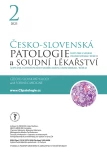-
Medical journals
- Career
Molecular diagnosis of complete and partial hydatidiform moles
Authors: Martina Putzová 1; Šárka Hadravská 1,2; Magdaléna Daumová 1,2
Authors‘ workplace: Bioptická laboratoř s. r. o., Plzeň 1; Šiklův ústav patologie LF UK a FN Plzeň 2
Published in: Čes.-slov. Patol., 59, 2023, No. 2, p. 64-67
Category: Reviews Article
Overview
Complete and partial hydatidiform moles are abnormal products of conception that can be identified by clinical, ultrasonographic, morphologic, histologic, and genetic methods. The diagnosis is usually confirmed only by histological examination. However, accurate diagnosis based on morphological criteria is difficult and some studies have shown that misclassifications are common, even when analysed by highly experienced pathologists. Misdiagnosis may mean that women are either not included in adequate β-hCG follow-up with the risk that the hydatidiform mole progresses to choriocarcinoma or, conversely, are included in follow-up unnecessarily. A reliable complementary method to pathological interpretation may be genetic analysis of the conceptus to eliminate the diagnostic dilemma by distinguishing non-molar spontaneous abortions from hydatidiform moles and defining the type of hydatidiform mole. The aim of our short paper is to introduce the routine molecular analysis used in our laboratory to a wider range of clinical pathologists.
Keywords:
Aneuploidy – hydatidiform mole – molecular genetic analysis – STR
Sources
1. Berkowitz RS, Goldstein DP. Clinical practice. Molar pregnancy. N Engl J Med 2009; 360 : 1639-1645.
2. Kajii T, Ohama K. Androgenetic origin of hydatidiform mole. Nature 1977; 268 : 633-634.
3. Lawler SD, Fisher RA, Dent J. A prospective genetic study of complete and partial hydatidiform moles. Am J Obstet Gynecol 1991; 164 : 1270-1277.
4. Hui P. Molecular diagnosis of gestational trophoblastic disease. Expert Rev Mol Diagn 2010; 10 : 1023-1034.
5. Golubovsky MD. Postzygotic diploidization of triploids as a source of unusual cases of mosaicism, chimerism and twinning. Hum Reprod 2003; 18 : 236-242.
6. Bestor TH, Bourc’his D. Genetics and epigenetics of hydatidiform moles. Nat Genet 2006; 38 : 274-276
. 7. Nguyen NM, Slim R. Genetics and Epigenetics of Recurrent Hydatidiform Moles: Basic Science and Genetic Counselling. Curr Obstet Gynecol Rep 2014; 3 : 55-64.
8. Murdoch S, Djuric U, Mazhar B, et al. Mutations in NALP7 cause recurrent hydatidiform moles and reproductive wastage in humans. Nat Genet 2006; 38 : 300-302.
9. Parry DA, Logan CV, Hayward BE, et al. Mutations causing familial biparental hydatidiform mole implicate c6orf221 as a possible regulator of genomic imprinting in the human oocyte. Am J Hum Genet 2011; 89 : 451 - 458.
10. Javey H, Borazjani G, Behmard S, Langley FA. Discrepancies in the histological diagnosis of hydatidiform mole. BJOG: An Internat J of Obstet & Gynaecol 1979; 86.6 : 480-483.
11. Messerli ML, Parmley T, Woodruff JD, Lilienfeld AM, Bevilacqua L, Rosenshein NB. Inter-and intra-pathologist variability in the diagnosis of gestational trophoblastic neoplasia. Obstet Gynecol 1987; 69.4 : 622-626.
12. Van Dongen, JJM, Langerak AW, Brüggemann M, et al. Design and standardization of PCR primers and protocols for detection of clonal immunoglobulin and T-cell receptor gene recombinations in suspect lymphoproliferations: report of the BIOMED-2 Concerted Action BMH4-CT98-3936. Leukemia 2003; 17.12 : 2257-2317.
13. Furtado LV, Paxton CN, Jama MA, et al. Diagnostic utility of microsatellite genotyping for molar pregnancy testing. Arch Pathol Lab Med 2013; 137 : 55-63.
Labels
Anatomical pathology Forensic medical examiner Toxicology
Article was published inCzecho-Slovak Pathology

2023 Issue 2-
All articles in this issue
- Mola či nemola, toť otázka
- Na patologii mě baví, jak to dohromady pasuje a když nepasuje, tak člověk musí přemýšlet proč
- Monitor aneb nemělo by vám uniknout, že...
- Hydatidiform mole
- Bleeding after childbirth / miscarriage - practical notes on the examination of biopsy material
- Spontaneous abortion in the first trimester of pregnancy
- Molecular diagnosis of complete and partial hydatidiform moles
- Skeletal dysplasias of the fetus and infant: comprehensive review and our experience over a 10-year period
- A case report: Acute kidney injury with progression to chronicity in an eldery woman
- Czecho-Slovak Pathology
- Journal archive
- Current issue
- Online only
- About the journal
Most read in this issue- Hydatidiform mole
- Spontaneous abortion in the first trimester of pregnancy
- Skeletal dysplasias of the fetus and infant: comprehensive review and our experience over a 10-year period
- Molecular diagnosis of complete and partial hydatidiform moles
Login#ADS_BOTTOM_SCRIPTS#Forgotten passwordEnter the email address that you registered with. We will send you instructions on how to set a new password.
- Career
